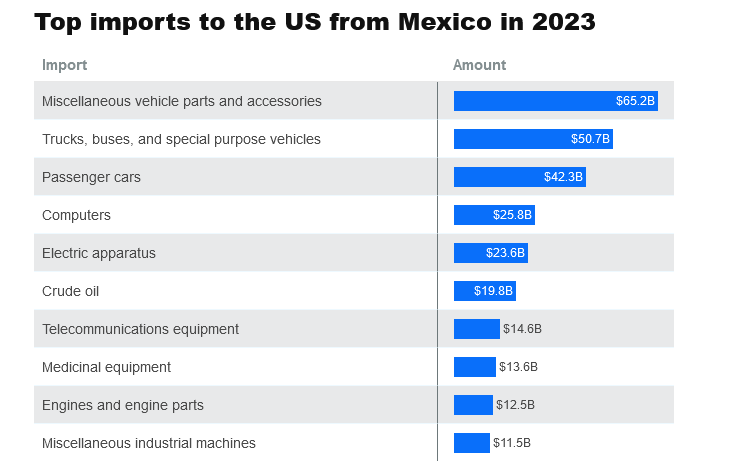Trump said he’ll charge up to an extra 25% on imports from Mexico, Canada, and China. Here’s what the US buys from them the most.

President-elect Donald Trump’s newly expanded proposal to increase tariffs on the US’ three largest trading partners could raise prices for a range of goods Americans rely on.
B-17 looked at what the US imports the most from Mexico, Canada, and China in order to determine the products most likely to see increased prices if Trump’s plans come to pass.
The biggest categories are oil, electronics, and vehicles.
On Monday night, Trump posted on his social media platform Truth Social that on his first day in office, he would “sign all necessary documents” to impose a 25% tariff on goods imported from Mexico and Canada. He also threatened a 10% tariff on imports from China “above any additional” tariffs on that country.
While the feasibility and legality of Trump’s proposal are still unknown, if implemented, proposed tariffs could impact a wide range of goods Americans use daily. The Census Bureau reported that in 2023, the US imported a total of about $1.3 trillion in goods from China, Mexico, and Canada combined.
From Canada, the top 2023 imports included over $92 billion worth of crude oil, $34 billion in passenger cars, and almost $9 billion in natural gas.

The US also imported $65 billion worth of car parts from Mexico in 2023, along with $26 billion in computers, $20 billion in crude oil, and almost $14 billion in medicinal equipment.

China, meanwhile, is a major supplier of electronics to the US. The Census data showed that in 2023, the US imported $67 billion in cellphones and other household goods from China, $37 billion in computers, and $32 billion in games, toys, and sporting goods.
Some companies have already been preparing to increase prices as a result of Trump’s tariff plans on the campaign trail. Walmart CFO John David Rainey told CNBC on November 19 that price hikes are likely on the horizon if Trump implements his tariffs: “We never want to raise prices. Our model is everyday low prices. But there probably will be cases where prices will go up for consumers.”

This is the most detailed tariff plan Trump has released to date. On the campaign trail, the president-elect did not detail specific tariffs on Canada and Mexico — he proposed a 60% tariff on all imports from China, along with a 10-20% tariff on goods imported from anywhere else.
Trump appears to be using this round of tariff threats to push for changes in migration and drug policy in the targeted nations. “This Tariff will remain in effect until such time as Drugs, in particular Fentanyl, and all Illegal Aliens stop this Invasion of our Country!” Trump wrote of the Mexico and Canada tariffs.
Some political leaders in Canada responded to Trump’s threat on Monday night. François Legault, the premier of Quebec, wrote in a post on X that Trump’s plan “poses an enormous risk” to Quebec and Canada’s economies, adding that “we must do everything possible to avoid 25% tariffs on all products exported to the United States,” per a translation from X.
Additionally, Trump’s plan could spark legal issues. Arturo Sarukhan, a former Mexican ambassador to the US, wrote in a post on X that the tariffs would violate the United States-Mexico-Canada agreement, a free trade agreement negotiated by Trump in his first term that went into effect in July 2020.
Companies and economists have warned that Trump’s tariff plans would increase consumer prices. B-17 previously reported that Trump’s broad tariff proposals are likely to increase prices across the board, from clothes and footwear to computers and video games.
Trump has denied that would be the case. “I am going to put tariffs on other countries coming into our country, and that has nothing to do with taxes to us. That is a tax on another country,” Trump said in an August speech.
The tariffs implemented during Trump’s first term did not significantly impact inflation, but his proposals for his second term are much broader and could have a larger impact on prices if implemented.
At this point, however, Trump’s tariff proposals could still change. During his first term in 2019, Trump announced new tariffs on Mexico with the aim of strengthening the border, but following criticism from lawmakers — including some Republicans — he withdrew the tariff plan.






